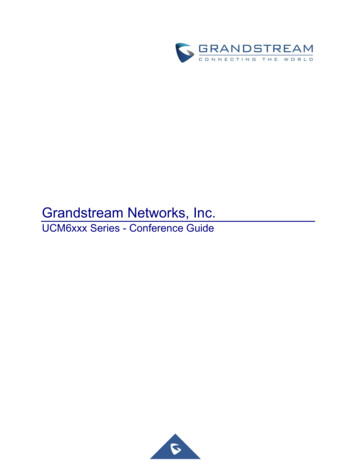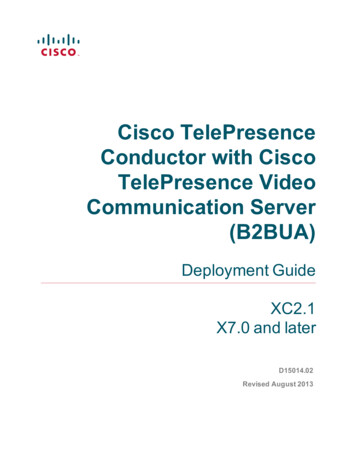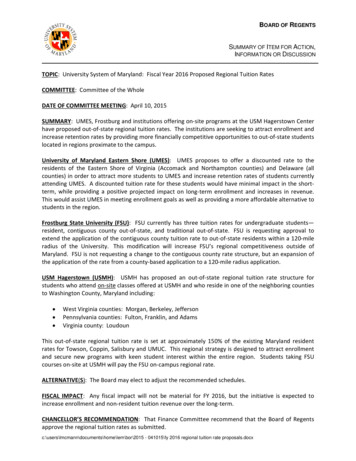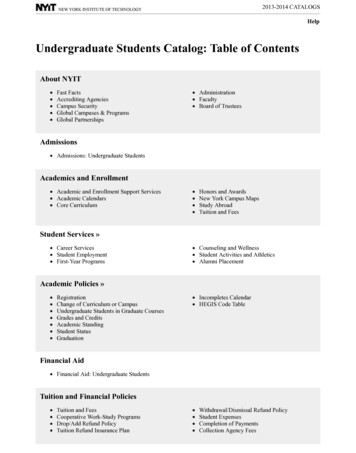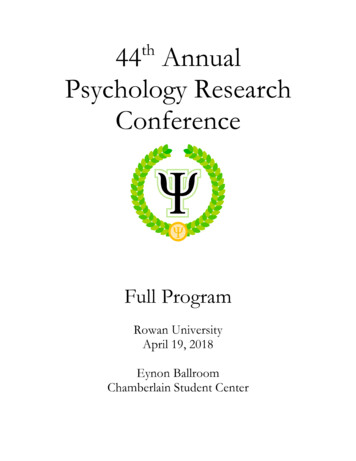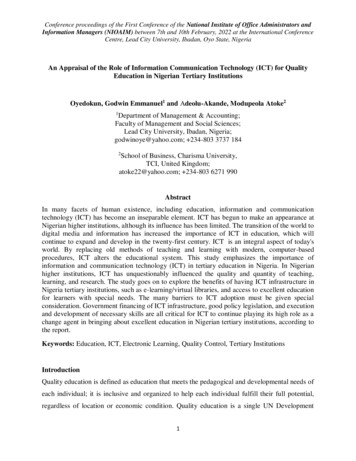
Transcription
Tenth AnnualUndergraduate Research Conferenceat the Interface ofBiology and MathematicsOctober 27-28, 2018University of Tennessee Conference CenterKnoxville, TNCONFERENCE OVERVIEWWelcome! This conference is hosted by the National Institute for Mathematical and BiologicalSynthesis (NIMBioS), housed on the campus of the University of Tennessee‐Knoxville.Undergraduate students conducting research in mathematics and biology will present over 50oral and poster presentations. A keynote address by Dr. Holly Gaff and featured talk by Dr.Nina Fefferman will take place Saturday afternoon, and a panel discussion on careeropportunities will follow. Graduate opportunities will be showcased on Sundaymorning. Poster abstracts start on page 5, oral presentation abstracts start onpage 16.
NIMBioSThe National Institute for Mathematical and Biological Synthesis is a center that bringstogether talented researchers in the fields of math and biology from all over the world.At NIMBioS, researchers work to cross the boundaries of their disciplines and addressthe many questions and challenges of 21st century biology. Currently in its eleventhyear, NIMBioS is sponsored by the National Science Foundation, with additionalsupport from the University of Tennessee‐Knoxville. NIMBioS also coordinates manyeducational programs including a summer research experience for undergraduatesprogram and workshops for math and biology faculty. For more information on NIMBioS and its research andeducational opportunities please visit www.nimbios.org.UNIVERSITY OF TENNESSEE & KNOXVILLEThis conference is being held at the University of Tennessee (UT) Conference center, just across town from theuniversity’s main campus. UT has an enrollment of over 27,000 and more than 300 degree programs offered.It was founded in 1794 as Blount College but subsequently changed names a few timesbefore becoming the University of Tennessee in 1879.Knoxville is the second‐oldest and third‐largest city in Tennessee. The prominentSunsphere west of the conference center is a remnant of the 1982 World’s Fair themedon energy, due to Knoxville’s close connections to the Tennessee Valley Authority andOak Ridge National Laboratory. Also nearby is downtown with restaurants and shopsfound on Gay Street, Market Square, and the Old City.INFORMATION FOR HANGING POSTERSThere will be two poster sessions. The first will immediately follow dinner on Saturday, from 7:30‐8:30 pm.Presenters whose posters are assigned odd numbers will present at this time. The second will precede lunchon Sunday, from 11:00 am to Noon, when posters assigned even numbers will be presented. Please hang yourposter as soon as possible and leave it up for the duration of the conference. Refer to the poster listing in thisbooklet to find your assigned number. Posters will all be hung in the hallway areas outside room 406. Findyour assigned space and use the tacks provided to affix it to the wall or poster board. Poster abstracts andnumbering start on page 5.INFORMATION FOR ORAL PRESENTERSRefer to the schedule to find your presentation time and room number. You will have 15 minutes to speak anda few minutes to answer questions. Also, note the nearest meal or break before your presentation. At thattime, please see a meeting moderator to have your talk loaded onto the appropriate computer in advance.SOCIAL MEDIA AT URC 2018Twitter: Check Twitter for live updates, highlights from sessions, and more. Follow us by visitinghttps://twitter.com/NIMBioS. Twitter users ‐‐ just login and click “follow.”View and join in conversations about URC 2018 on Twitter by using the hashtag, #nimbiosURC. If you don’thave a Twitter account, you can still view our updates or bookmark the NIMBioS Twitter webpage.1
KEYNOTE LECTUREDr. Holly GaffDepartment of Biological SciencesOld Dominion UniversityMapping the Range Expansion of Ticks: Modeling and SurveillanceTicks and tick‐borne diseases are on the move worldwide. Tracking these movements is critical tounderstanding the risks of the diseases. Mathematical models can be used to explore tick‐borne pathogendynamics, quantify risk of tick‐borne disease, and identify optimal strategies to reduce that risk. Long‐termsurveillance data are needed to build ecologically valid models. In order to build such a dataset, ticks havebeen collected since 2009 using a variety of techniques from a set of locations in Virginia. This surveillanceproject has collected, identified, and cataloged more than 175,000 ticks. While the vast majority of these ticksare the expected three tick species, this study also found two tick species moving into the area. We havecarefully tracked these ticks through annual surveys of the majority of the eastern half of the state, and we areusing that data in combination with the long‐term local data. Agent‐based models have been parameterizedusing these data to explore the future disease dynamics in the region as a result of each type of invasion. Themodels predict that the population front and pathogen prevalence are highly dependent on the hostdynamics. This has led us to shift more focus on identifying hosts in these expansion areas.FEATURED SPEAKERDr. Nina FeffermanDepartments of Ecology and Evolutionary Biology and MathematicsUniversity of Tennessee, KnoxvilleEvolving Efficient Solutions: How Simple Natural Systems Solve the Most ComplicatedProblemsNature is replete with biological systems of very simple agents that need to solve incredibly complicatedproblems in order to survive. Contrary to popular belief, evolutionary systems rarely produce algorithms thatfind optimal solutions – instead, they produce efficient algorithms to find sufficient solutions. We’ll discusssome of the mechanisms at work in nature for how this is accomplished and explore a case study in cyber‐security designed by the communication system of honey bees.2
SCHEDULESaturday, October 27: Room 413AB (Except where noted)12:45‐1:00 Welcome: Dr. Louis Gross, NIMBioS1:00‐2:00 Keynote Lecture:Dr. Holly Gaff, Biological Sciences, Old Dominion UniversityMapping the Range Expansion of Ticks: Modeling and Surveillance2:10‐2:25406: Nicolas Gort Freitas – Scaling of Information in Biochemical Systems413AB: Sarah Brock, Yi Dai, and Brielle Kwarta – Economic Modeling of Free‐Roaming Cats in Knox County,TN2:30‐2:45406: Allison Torsey – Analyzing the Dynamics of an Inflammatory Response to a Bacterial Infection in Rats413AB: Eeman Abbasi, Kevin De Angeli, and Alan Gan – Modeling Hunting and Harvesting InteractionsBetween Plants and Their Seed Dispersers2:50‐3:05406: Brianna Alred, Benjamin Reber, and Benjamin Schenck – Ecological Niche Modeling and RiskAssessment of Thousand Cankers Disease413AB: Alyssa Petroski – Investigating Density‐Dependent Effects on Fitness of the Dengue and Zika VectorAedes aegypti and Possible Consequences for Wolbachia‐Based Control Strategies3:10‐3:25406: Leah Andrews – Modeling Optimal Treatment Strategies for Transplant Patients413AB: Annastashia Blesi and Samantha Brozak – La Crosse Virus Spread Within the Mosquito Population inKnox County, TN3:30‐3:45 Opportunities at NIMBioS and Explanation of Networking ActivityGreg Wiggins, Education & Outreach Coordinator at NIMBioS3:55‐4:25 Networking Activity and Snack Break4:30‐5:20 Featured Speaker:Dr. Nina Fefferman, Ecology and Evolutionary Biology and Mathematics, University of TennesseeEvolving Efficient Solutions: How Simple Natural Systems Solve the Most Complicated Problems5:30‐6:20 Career Panel (Moderator: Suzanne Lenhart, Associate Director at NIMBioS)Dr. Holly Gaff, Biological Sciences, ODUDr. Nina Fefferman, Ecology and Evolutionary Biology and Mathematics, UTKDr. Olivia Prosper, Mathematics, University of KentuckyDr. Karin Leiderman, Applied Mathematics and Statistics, Colorado School of Mines6:25‐6:35 Introduce Kristin Jenkins, Director, BioQUEST, and Stacey Kiser, Professor, Lane Community College6:40‐7:30 Buffet Dinner in 404A7:00Turn in SET game sheets to Wiggins or Lenhart at Dinner7:30‐8:30 Poster Session I: Odd numbered posters presented (and desserts)3
Sunday Morning, October 28: Rooms 406, 413AB, 413C8:00 Continental Breakfast8:30‐8:45406: Tyler Helton – Applications of the Monte Carlo Method for Problem Solving413AB: Kimberlyn Eversman – Division of Labor in Hygienic Behavior of Apis mellifera: ExperimentalInvestigation to Simulation8:50‐9:05406: Kelly Rivenbark – Manzate Exposure Alters Mitochondrial Membrane Potential in Genetically ModifiedC. elegans413AB: Mariya Savinov – Entrainment of Forced Oscillators with Flexible Periods9:10‐9:25406: Abdullah Ateyeh and Rithik Reddy – Using Global Sensitivity Analysis to Find Influential Parameters ina Wound‐Healing Model413AB: Alena Turner – Simulating an Outbreak of Zika Virus in Climates with Seasonal Mosquito Patterns9:30‐9:45406: Nastasha Gilbert – Using C. elegans as a Model for Non‐Nutritive Sweetener and Glucose Metabolism413AB: Noah Rosenbalm – Disease Progression on Social Networks9:50‐10:50413C: Graduate School Opportunities Showcase11:00‐12:00: Poster Session II: Even numbered posters presented12:05‐12:55 Lunch1:00‐1:15406: Rebekah Waters – 3D Printing and Microfluidics413AB: Jordan Pellett – Efficacy of Control in a Spatially Dynamic Model of White‐nose Syndrome1:20‐1:35406: Amanda Ignacz – Chronic Exposure to Manzate Formulation in Genetically Modified Caenorhabditiselegans Leads to Mitochondrial Dysfunction413AB: Jerry Yang – Estimating Rates of Homologous Recombination in Bacteria1:45‐2:00413AB: Closing Remarks2:00 Adjourn4
POSTER ABSTRACTS1) ALOISO, M, and B. G. FITZPATRICK. Modeling Ecological Federalism in a Pest Control Context.Department of Mathematics, Loyola Marymount University, Los Angeles, CA.Recent changes in the federal government's approach to environmental regulation suggest a rolling back ofenvironmental policies to leave management to state and local authorities. Economic federalism concerns thebalancing of centralized (federal) and decentralized (regional) decision making. While environmentalfederalism has seen much debate and theorizing, quantitative modeling and analysis is in the nascent stages.In this project, we pose a regulatory problem in which two neighboring areas are controlled by distinctregional governments and a federal government to explore the outcomes of differing regulatory regimes. Wedevelop a dynamic model of a pest population that grows within regions and disperses across a regionalboundary. Regulatory control is implemented by a combination of harvesting and border control, allowingdecision makers to focus on preventing pest immigration and/or on reducing the existing population. Usingoptimal control and game theory techniques, we seek cost‐efficient pest control strategies under differentregulatory frameworks and data feedback strategies.2) ANDRADE, A., S. NAIK, and M. WERBICK. Identifying and Evaluating the Impact of On‐ and Off‐CampusContext Dependent Ecological Factors on the Patterns of Health Risk Behaviors Among Arizona StateUniversity Students. School of Human Evolution and Social Change, Arizona State University, Tempe, AZ.Ecological model systems can be used to analyze behaviors and their correlations to ecological factors, whichis useful in determining how social environmental factors influence an individual’s decisions. Environmentalinteractions shape the way that humans behave throughout the day, either through observation, action, orconsequences. A research study was conducted in the form of a survey to determine and evaluate the impactof ecological factors in drinking and smoking behaviors among Arizona State University students. Ecologicalfactors such as demographics, living conditions, social interactions, and where students spend the most timewere used to evaluate the correlations between drinking and smoking behaviors and environmentalinteractions, both on‐ and off‐ campus. A 27 question survey was administered to 539 Arizona State Universitystudents to conduct this research. Summary statistics, correlation techniques, linear regression, and logisticregression models were used to find correlations and relationships between patterns of health risk behaviorsand ecological factors.3) ANDRADE, C.1, A. DAWADI1, M. JACKSON1, N. GRIFFIN1, J. TOLONE1, C. FAY1, D. MOREL1, and J. DICK2.Development of a Night Interruption Light Therapy Delivery Apparatus for Field Treatment of Hop Plants.1Department of Physics, Emory & Henry College, Emory, VA, 2Kelly Ridge Farms, Meadowview, VA.The short‐day plant Humulus lupulus, or hops, relies on night length to control growth. When night length isrelatively long, as is the case in southwestern Virginia in summer, hop plants do not grow as tall as they do inthe northwestern US. Growth triggers in hop plants are partially controlled by photoreceptors calledphytochromes. Of particular interest are those phytochromes sensitive to the red and far red wavelengths oflight. When exposed to red light, the inactive form of phytochrome (Pr ‐ Phytochrome red) is converted to theactive form (Pfr ‐ Phytochrome far red), the latter regulating growth processes. At night, only Prphytochromes are synthetized. To counter the effect of longer night lengths and promote conversion of Pr toPfr, three types of LED‐based, Arduino‐controlled, light delivery structures are under development. With theuse of spectrometers, measurements of intensity as a function of wavelength give a profile of the illuminationdelivered by each array. The most efficient type of LED light for hop plants can be determined by comparingspectral data with the desired peak wavelength of 657 nm red light for conversion of Pr to Pf. Furthermeasurements can verify calculations of the effective intensity of the light at various distances from thesource, suggesting treatment regimens.5
4) BUTLER, C.1, J. CHENG2, L. CORREA3, M. PRECIADO4, A. RIOS5, B. ESPINOZA6, V. MORENO6, C. MONTALVO6,and C. KRIBS7. Comparison of Screening for Methicillin‐Resistant Staphylococcus aureus (MRSA) at HospitalAdmission and Discharge. 1Department of Mathematics and Statistics, University of Maine, Orono, ME.2College of Science, Shanghai University, China. 3Escuela de Ciencias Matemáticas y Tecnología Informática,Universidad Yachay Tech, Ecuador. 4Escuela de Física y Nanotecnología, Universidad Yachay Tech, Ecuador.5Departamento de Estadística, Universidad Nacional de Colombia, Colombia. 6Simon A. Levin MathematicalComputational and Modeling Sciences Center, Arizona State University, Tempe, AZ. 7Department ofMathematics, University of Texas, Arlington, TX.Methicillin‐resistant Staphylococcus aureus (MRSA) is a significant contributor to the growing concern ofantibiotic resistant bacteria, especially given its stubborn persistence in hospital and other health care facilitysettings. In combination with the general persistence of S. aureus (colloquially referred to as staph), MRSApresents an additional barrier to treatment and is now believed to have colonized two of every 100 peopleworldwide. According to the CDC, MRSA prevalence sits as high as 25‐50% in countries such as the UnitedKingdom and the United States. Given the resistant nature of staph as well as its capability of evolving tocompensate antibiotic treatment, controlling MRSA levels is more a matter of precautionary and defensivemeasures. The subject of the following research is the method of "search and isolation" which seeks to isolateMRSA positive patients in a hospital to decrease infection potential. Although this strategy of search andisolate is straightforward, the question of just whom to screen is of practical importance. We comparescreening at admission to screening at discharge. To do this, we develop a mathematical model and use bothstochastic and deterministic simulations to determine MRSA endemic levels in a hospital with either controlmeasure implemented. The more successful control measure will better control endemic potential andproliferation of MRSA.5) CHIDAMBARAN, S.1, D. CASTEDO PENA2, and A. BERLE3. Applying Phylogenetic Tools to UnderstandCancer Tumor Evolution. 1Rutgers University, New Brunswick, NJ, 2North Carolina State University, Raleigh,NC, 3Lewis and Clark College, Portland, OR.Because of the high speed of replication and mutation in cancer cells, cancer can be modeled as a within hostevolutionary process. Here we apply a new model of evolution, Selection on Amino acids and Codons (SelAC),to cancer data and compare it with previously accepted models. In our analysis, SelAC was comparable to thealternate models tested, FMutSel0 and GY94. However, we will need to continue testing if this applies across abroader range of genes. Additionally, we created R scripts to extract relevant data from .maf files and use itcombined with information from the human reference genome to simulate cancer sequences. We alsoconducted a principal component analysis (PCA) to determine which of 30 physicochemical properties bestexplain the variance in amino acid residues. Our results point to SelAC being an accurate model of evolutionfor cancer, but future work needs to be done in testing and improving the model to confirm these initialresults.6) COLLINS, R. Investigating Anti‐Angiogenesis Therapy for Cancer with a Mathematical Agent‐Based Model.Texas Tech University, Lubbock, TX.Cancer modeling can be used to better understand the growth and metastasis of cancer cells by investigatinghow individual parameters influence growth dynamics. Tumor growth and metastasis depend on angiogenesis,the development of blood vessels to supply the tumor with the oxygen and nutrients needed to proliferate.Antiangiogenic therapy, using angiogenic inhibitors which prevent blood vessel growth to the necrotic core ofthe tumor, can ideally slow the spread of cancer cells by essentially starving the tumor of the nutrients neededto survive. Here, an agent based mathematical model was developed to investigate tumor responses toantiangiogenic therapy. The model tracks the distribution of healthy and cancer cells while exploring theefficiency of using different levels of angiogenic inhibitors. The process of introducing antiangiogenic therapy6
was simulated by lowering the cell efficiency of cancer cells compared to healthy cells so it is more difficult forcancer cells to take up glucose, as it would be if there were no blood vessels to supply glucose to the core ofthe tumor. As the level of antiangiogenic factors is increased, the tumor ceases to grow or grows at a muchslower rate. The applications of math based modeling for cancer help shed light onto complex dynamics thatallow tumor proliferation.7) DAWADI, A.1, M. JACKSON1, ANDRADE, C.1, N. GRIFFIN1, J. TOLONE1, C. FAY1, D. MOREL1, and J. DICK2.Assessing the Efficiency of Night Interruption Light Therapy on the Growth of Short‐Day Plants in Virginia.1Department of Physics, Emory & Henry College, Emory, VA, 2Kelly Ridge Farms, Meadowview, VA.The per plant production of Humulus lupulus, or hops, in the northwest of the United States far exceeds thatof Virginia. Hops are short‐day plants dependent on night length to reach maturity before flowering. Lowerlatitude regions have longer nights during the growing season which influences the flowering process.Implementation of Night Interruption can mitigate this impact and thus increase production, leading to a morecompetitive hops industry in the region. Night Interruption is the use of artificial light to mislead the plants’photoreceptors, causing the plants to register night as day‐time. This process targets two different forms ofphytochrome photoreceptors: the active form (Pfr ‐ phytochrome‐far‐red) which controls flowering, leaf andchloroplast development; and the inactive form (Pr ‐ phytochrome red). At night, only the Pr form issynthesized. When red light with peak wavelength at 657 nanometers is applied, Pr phytochromes convert toPfr. The implementation of night interruption enables the plants to convert Pr to Pfr thus promoting growth.As part of a larger project, we propose to study night interruption light therapy in hops and biologicalequivalents. This experiment will include field testing with delivery of red light over different time intervalsthroughout the night on hop plants to provide information on the most efficient application of nightinterruption in this region.8) GEORGE, S., L. MORA, C. OROZ, and D. TALLANA. The Effect of Gonadotropin‐Releasing Hormone (GnRH)on the Regulation of Hormones in the Menstrual Cycle: A Mathematical Model. Mathematical andTheoretical Biology Institute, Arizona State University, Tempe, AZ.Gonadotropin Releasing Hormone (GnRH) is the driving force for hormonal regulation during the menstrualcycle. GnRH signals the anterior pituitary gland to secrete follicle stimulating hormone (FSH) and luteinizinghormone (LH) which promotes the release of estradiol (E2) and progesterone (P4). Interferences in the cyclicinteractions have been shown to cause irregularities in the menstrual cycle. In this study, the non‐lineardynamics of GnRH, FSH, LH, E2, and P4 are examined. A simplified model of six non‐linear ordinary differentialequations is developed to model the effect of GnRH on the dynamics of hormones in the menstrual cycle. Amathematical analysis is performed to observe the regulation of GnRH in a monthly cycle. Our findingssuggest that the relationship between E2 and GnRH plays an important role in concentrations and patterns ofrelease of the hormones involved in the menstrual cycle.9) GRIFFIN, N.1, J. TOLONE1, ANDRADE, C.1, A. DAWADI1, M. JACKSON1, C. FAY1, D. MOREL1, and J. DICK2.Implementation of Night Interruption Light Therapy on Short‐Day Plants via a Mobile Delivery System.1Department of Physics, Emory & Henry College, Emory, VA, 2Kelly Ridge Farms, Meadowview, VA.The growth of hop plants (Humulus lupulus) depends on the duration of night. Because of different daylengths, hops cultivated at lower latitudes do not produce the same yield as those grown in the PacificNorthwest. This lack of growth can be mitigated by what is known as night interruption light therapy. This isthe process of shining specific wavelengths of light on the plants at night to make their biochemistry react as ifit were daytime. To effectively and efficiently implement this concept, an automated mobile delivery system isunder development. The primary goal is to evenly deliver light across acres of hop plants while keeping costswithin reach of farmers. One challenging aspect of the project is that the plants grow to heights of up to7
twenty feet. For this reason, cables are suspended down the rows of plants for the machine to use like a track.The mechanism will support a lighting module that will traverse the rows. The motion of the unit will beremotely controlled to move along the track in order to evenly distribute light to the plants.10) GUY, K., and D. ERNST. Reanalyzing the NEOS Experiment Through Computational Modeling.Department of Mathematics and Computer Science, Fisk University, Nashville, TN.A phenomenon called the “reactor neutrino anomaly” reports a disappearance of neutrinos with respect tothe number that is expected being emitted from reactors. The existence of a fourth, sterile neutrino has beenproposed as the possible solution to this problem. A recent experiment, named NEOS (Neutrino oscillations atshort baseline) sees evidence of disappearance. The purpose of this work is to create a computer model ofthe new NEOS experiment which would first follow as closely as possible the analysis performed by theexperimentalists. Reproducing the results of the experimentalists would verify and calibrate our model. Wewould then investigate possible improvements in the model. Our best model would be combined with twentyother models under construction by the Vanderbilt Theoretical Neutrino group. The implications of thisanalysis would clarify the possible existence of the fourth sterile neutrino, as well as provide the parametersthat would govern the oscillations of the known neutrinos into the new sterile neutrino should we findevidence for its existence.11) HILL, E., and M. JACKSON. The Distribution of Neutral Hydrogen in the Milky Way Galaxy. Emory andHenry College, Emory, VAThe Milky Way is a spiral galaxy composed of neutral hydrogen (HI) gas. the Milky Way’s can be representedby plotting blue‐shifted and red‐shifted neutral HI gas which is concentrated in four spiral arms. To locate HI inthe galaxy, we collected data along the 21 cm hydrogen line using a small radio telescope (SRT) at VirginiaTech. In the laboratory, the 21 cm line occurs at a frequency of 1420.4 Mhz. Red‐shifted gas moving awayfrom the Sun displayed frequencies lower than the HI emission line while blue shifted displayed higherfrequencies. We then used these frequencies to calculate the radial velocities of the gas. These calculationsassumed that the orbital velocity of HI gas beyond the orbit of the Sun was equivalent to that of the Sun. Thisassumption was based on evidence from galactic rotation curve data (see poster by Madison Jackson et al.).The distance from the HI clumps to the Sun were then calculated utilizing trigonometric equations. This, alongwith the galactic longitude at which the data were taken, represented the galactic coordinates of the gas.When the HI gas was plotted, the data appeared to reveal spiral arms, indicating that the Milky Way is a spiralgalaxy, in general agreement with previous high‐resolution data.12) HOARD, E. Using graph theory to evaluate size‐structured food webs. Department of Biological Science.Department of Mathematics and Statistics, Murray State University, Murray, KY.Graph theory has the potential to elucidate food web interactions because of the logical similarity betweenthem. A particularly interesting problem in this regard is the impact of size‐structure, the variation in sizewithin a population, on food webs. Size‐structure is common within animals, but the impacts of such variationon food web interactions are not well understood. To evaluate this question, we studied several size‐structured populations of a top aquatic predator, the tiger salamander (Ambystoma mavortium).Paedomorphic tiger salamanders are keystone predators in subalpine ponds, but how size variation affectstheir predatory impacts is unknown. We sampled salamanders in three ponds at the Mexican Cut NaturePreserve in south‐central Colorado, which provides an ideal location to study how salamander prey choice isaffected by size‐structure. Using non‐invasive gastric lavage, we sampled the stomach contents ofsalamanders across a representative range of sizes in each pond. We also sampled the abundance ofinvertebrate prey and phytoplankton in order to evaluate possible trophic cascades. By analyzing these data8
using graph theory, we will quantify the strength of the predator‐prey relationships between each size classand their prey species, and describe how size variation affects predator‐prey dynamics of these communities.13) JACKSON, M., and E. HILL. Producing a Galactic Rotation Curve for the Milky Way Galaxy. Emory andHenry College, Emory, VA.A galactic rotation curve is a graph of the velocity of intergalactic objects from the center of the galaxy. Theorbital velocities of are related to the mass of the intergalactic object’s orbit. In this study, a galactic rotationcurve was created for the Milky Way galaxy using the 21 cm line of neutral hydrogen. When neutralhydrogen’s electron has an antiparallel spin, the energy level is lower than the hydrogen with a parallel spin –when the spin transitions to antiparallel the energy is released as electromagnetic radiation. This radiationwas detected with a small radio telescope (SRT) at Virginia Polytechnic Institute with a rest frequency of1420.42 MHz. The SRT took samples every two degrees longitude from 20 ‐ 260 for a duration of 300 secondseach. The points 20 ‐90 were used for this rotation curve. The remaining data were used as a continuation ofrelated research for mapping of the neutral hydrogen clumps throughout the galaxy (after establishingassumptions from the rotation curve). Trigonometric equations were applied to calculate the distance of thehydrogen gas from the galactic center. By assessing the Doppler shift of the gas’ maximum orbital velocity wascalculated. The distance and orbital velocity resulted in a galactic rotation curve for the Milky Way Galaxy.14) JOHNSON, A.1, and A. WALKER2. Parameter Estimation in Models of Sphagnum Gross PrimaryProduction using Advanced Markov Chain Monte Carlo Methods. 1University of Tennessee, Knoxville, TN,2Environmental Sciences Division and Climate Change Science Institute, Oak Ridge National Laboratory, OakRidge, TN.Peatlands harbor large stockpiles of carbon, which are vulnerable to rising temperatures and increasingprecipitation in northern wetlands. Peatlands account for 0.2 – 0.33 of the Earth’s soil carbon, and thispeatland carbon is vulnerable to recent and future climate change. The potentially large feedback of CO2 andCH4 on climate change as this carbon degrades makes predictive understanding of peatland carbon dynamicsimperative. We contribute to this predictive understanding by establishing formal parameter estimationmethods in models of Sphagnum gross primary production (GPP). In this study, we implemented advancedMarkov chain Monte Carlo methods in the Multi‐Assumption Architecture and Testbed (MAAT), a modelingsoftware. We then compared alternative Sphagnum GPP models. The Dynamic Leaf Area Index model ofSphagnum GPP incorporates a hypothesis on the interaction between photosynthesizing tissue surface areaand water table height. In contrast, the Constant Leaf Area Index model does not include this hypothesis. Byanalyzing data from Oak Ridge National Lab’s Spruce and Peatland Responses Under Changing Environments(SPRUCE) experiment in northern Minnesota, we concluded that the Dynamic
Old Dominion University Mapping the Range Expansion of Ticks: Modeling and Surveillance Ticks and tick‐borne diseases are on the move worldwide. Tracking these movements is critical to understanding the risks of the diseases. Mathematical models can be used to explore tick‐borne pathogen



